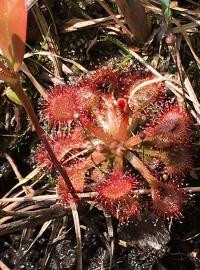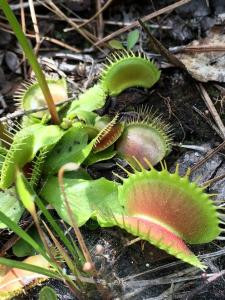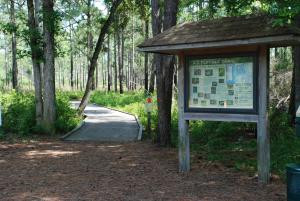Most kids dream of sandy shores and ocean waves when visiting Wilmington, but for my eight-year-old son, Rowan, the trip had a singular, fascinating purpose: witnessing Venus flytraps in their natural habitat. Carolina Beach State Park, more than just trails, campgrounds, and a marina, offered us a unique ecosystem – one of the rare places in the United States where Venus flytraps grow wild. We weren’t just visiting a park; we were on a quest to discover Where To Find A Venus Fly Trap in the wild.
Alt text: Vibrant pitcher plants, carnivorous flora of Carolina Beach State Park, showcasing nature’s wonders.
Equipped with a trail map from the Visitor’s Center, we embarked on the Flytrap Trail. My younger son, Sylvan, amused himself with binoculars, turning them the wrong way to make me comically small. Little did he know, the object of our search was indeed small, yet monumental in our imaginations. Venus flytraps, these carnivorous wonders, often feature in tales and cartoons, sometimes even depicted as enormous, plant-eating monsters. Despite our map, the initial hunt proved challenging. Then, Rowan’s sharp eyes spotted them: “Pitcher plants!” he exclaimed, pointing towards a boggy area.
These pitcher plants grew in dense clusters, resembling greenish-yellow tubes with hooded openings. Nature’s ingenious traps, they lure insects inside, preventing escape. Rowan, now fueled by discovery, pulled out his magnifying glass. He and Jenn, my wife, settled onto the boardwalk, meticulously examining the ground. The key, we learned, was to look small, to observe the subtle details. This close observation led us to our next botanical find: sundew. Nestled near the pitcher plants, sundew plants displayed delicate, pinkish tentacles, each glistening as if perpetually holding tiny raindrops. These sticky droplets are how sundews ensnare their unsuspecting prey.
 Sundew plant at Carolina Beach State Park
Sundew plant at Carolina Beach State Park
Alt text: Glistening sundew plant with sticky droplets, a carnivorous marvel found on the Flytrap Trail.
Yet, the star of Carolina Beach State Park, the Venus flytrap, remained elusive. Our initial methods – reversed binoculars and intense magnified gazes – were clearly not working. What were we missing in our quest to find a venus fly trap?
Rowan, undeterred, declared his resolve to return the next day, refusing to leave until we had found our flytrap. I was skeptical, hoping he might forget. But that night, in our tent, Rowan’s whisper broke the silence, “Venus flytrap,” followed by a giggle. Forgetting was not an option.
The Visitor Center held the answer. The park ranger informed us we’d missed the guided flytrap tour but revealed a “secret” – a wooden structure marking a hidden path. Behind it, a trail of sawed-off stumps acted as natural steps. Returning to the trail, we slowed our pace, carefully scanning the undergrowth for the wooden marker. We located what looked like an old sign frame, and indeed, the sandy path behind it turned muddy, the stumps guiding our way. With heads swiveling, we meticulously examined the trail edges, Rowan’s constant question echoing, “Do you see one?”
 Venus flytrap at Carolina Beach State Park
Venus flytrap at Carolina Beach State Park
Alt text: Close-up of a Venus flytrap in its natural habitat, teeth visible, a highlight of the Flytrap Trail.
Distracted momentarily, I moved ahead, and then, in my peripheral vision, I spotted it – a Venus flytrap! It grew right beside the trail, smaller than my palm, its trap leaves open, the trigger hairs and teeth clearly visible. “Flytrap!” I called out.
The others rushed over, their earlier frustrations replaced with awe. Once we found one, they seemed to multiply. We discovered at least five Venus flytraps, all thriving along the trail’s edge. Rowan, now an experienced flytrap hunter, even guided another couple to these botanical treasures.
We admired them from a respectful distance. Touching a Venus flytrap’s trap too much can harm it, causing the leaves to blacken and die. Furthermore, poaching wild Venus flytraps is a felony in North Carolina – a testament to their rarity and the importance of conservation. Luckily, our Scooby-Doo knowledge instilled a healthy respect for carnivorous plants. Who knows when a small flytrap might just decide to become human-sized? Observing and appreciating from afar is the best way to ensure these plants remain for others to enjoy.
We took pictures, as if these tiny plants were honorary family members. We had journeyed far to find something small yet extraordinary. Mission accomplished: we discovered where to find a venus fly trap and so much more in the fascinating world of Carolina Beach State Park.
Discover More About Venus Flytraps at Carolina Beach State Park:
Carolina Beach State Park, located at 1010 State Park Road, Carolina Beach, North Carolina, is a prime location to witness Venus flytraps in their natural environment. Click here to delve deeper into the park’s unique ecology and plan your visit.
Seasonal Events to Enhance Your Flytrap Adventure:
 Flytrap Trailhead at Carolina Beach State Park
Flytrap Trailhead at Carolina Beach State Park
Alt text: Welcoming Flytrap Trailhead sign at Carolina Beach State Park, inviting exploration of carnivorous plant habitats.
While the specific events mentioned (Flytrap Family Fun Day, Hike NC Earth Day Trail Hike, Flytrap Frolic) were for 2018, Carolina Beach State Park and the surrounding Wilmington area regularly host events celebrating Venus flytraps and carnivorous plants. Check the park’s official website or local event listings for current and upcoming activities.
Ongoing Opportunities:
Carolina Beach State Park typically offers free guided carnivorous plant hikes on Saturdays and Sundays, from spring through fall. Visit the park’s website for the most up-to-date schedule and tour availability to maximize your chances of finding a venus fly trap and learning more about these incredible plants.